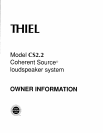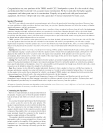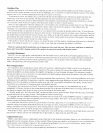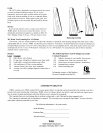
Stabilizer Pins
Speakers
positioned
on
a soft surface
such
as carpetin-s
are
able to rock
back ancl fbrth
slightly
and will
vibrate
in reactron
to
those tbrces
the speaker
-qenerates
to move
the driver
ditrphra-ems.
(Evt:rv
action
has an
equal ancl
opposite
reaction.)
This
speaker
motion
causes a loss
of
rnusical
infbnnation
and reduces
the
claritv
of
rhe
music.
To elirninate
this etfbct.
the THIEL
CS2.2
can
be used with
the
provrded
stabilizer pins.
The
pins
are
pushed
into
three
pre-
drilled holes
in tlle base
of
each speaker.
The
point penetrates
the
carpt't and
allows the
speaker
to rest firntly
on
the floor
underneath.
The three
pins
provide
a stable
foundation which
eliminat('s
some
obscuring
of infbrmation
and
procluces
a
cleaner.
more
articulate
souncl. No pins
are required when placing
the
speakers
on hard
or smooth surfaces.
There
are some applications
where
the
stabilizerpins
will nof
improre
the sound
but ma1,
actuallv
make it worse.
This situation
occurs when
the f-loor itself
is not
rigid
iind therefbre vibrates
when
connected
to the speakers
via
the stabilizer pins.
We
encourage
you
to expenment
to determine
whether
or not
this is
the case.
We
recommend
that
you
determine
the
position
of
your
speiikers
befrtre inserting
the
pointed
stabilizer pins.
To insert
the
pins.
tiltthespeakerfbrwardandpushthetwobackpinsiullyintothe
["det:pholeslocateclineachbackcorner-otthebase.Thenrock
the
speaker backrvard
and insert
the fiont pin.
Finallv. press
finnly
on
rhe
top
of the speaker
with
a slight
rocking
motion
until
the
pins penetrate
the calpet
completely.
To
check thtrt
the
pins
are finnly
seated.
tap the back
irnd side
of the
speaker. There
should
be no movement
and
the
speaker
should
f'eel
solidlv irr pltrce.
if
the speaker is
tnoved with
the
pins
in
place.
care
should
be taken
to
lift
the
speakers straight
up
until the
pins
have
cleared
the
calpet. AIso,
tilting
the speaker
so it's weight
is resting
on any single pin
can
dana-ee the
speaker's
wood
base.
Please
be cautioned
that
the
pointed
pins
can
be dangerous
if
not used with
care. They
can
cause small
dents
in hqrd,,lood
floors
and it is
possible
to
damage carpets
if the
speakers
are movecl
incorrectly
with
the
pins
in
place.
Associated
Equipment
The
CS2.2
is
a
very
high quality
sound reproducer
and
will
benefit fiom
use with
the best
associatecl
equiprnent.
Since
ir is
extremely
accurate. it will
reveal
sources of distortion
generated
elsewhere in
the system. For
example,
distortion resuiting
fiom
poor
recordings
or inferior
electronics
will
be reproduced
accurately.
Also.
the
quality
of the interconnect
cables
and
speaker
cables will
significantly
affect the
perfonnance
of the
system.
Power
Requirements
It is important
to have
enough
power
to
play
at the level you
desire without
distortion.
If high
sound
levels
are desired,
the
CS2.2s
are designed
to be used with
amplifiers rated
up
to 250 watts
perchannel.
If
you play
the
speakers
more loudly
than
the
volume
the
arnplifier can
cleanly
produce,
the
amplifier will produce
overloacl
(clipping)
clistortion.
This
clistortion
is actually
non-musical
adtlitiottul
energv and
since it is
concentrated
in the
high frequency
region
where
the speaker is
least
able to handle
it, tweeters
can be
darnaged in
extreme
cases.
Keep in mind
that soundclLrctlitt
is
usually much
more
important
than sound
cluantitt'. There
can
be large
differences
in
the sonic
peformance
of two amplifiers
of
equal
power,
and this is
more important
thern large
dif-ferences
in power.
Most
everyone
will
be
happier with
a 50 watt
amplifier of high
sonic
quality
than
with a 200 u,att
amplifier
of mediocre
sonic
quality.
For
this reason,
we
feel
there is no substitute
tbr listening
to make your
amplifier
decision.
The question
"how
much
power
do I need?"
does not have
a simple
answer because
it is not
determined
only by the
loudspeaker's
etficiency, but
also by
the
volume
desired
and the size
o1 the room.
If all three
factors
are average,
about
-50 watts
per
channel is required.
Each
factor
can raise
or
lower
this amount
by about
three times.
I
)
Usually,
people
who
"don't
like music
loud"
can decrease
their
porver
to
about one-half.
People
who like
music
loud
should
increase
their
power
by two times
or more. Most people
lall within
a normal
range.
2) A
speaker with
a
low
S4dBAV-m
efficiency
will
require
twice the
power
of
an average 87dBAV-m
speaker.
A speaker
with
a
high
90dBflil-m rating
will
require
only half
the
power
of an average
speaker.
The CS2.2 is
of average
efficiency
(86dB)
and
therefore
requires
an average amount
of
power.
3)Asmall
roomwill needlesspowerfbragivenloudnesslevel
than.rlargeroom.Averysmall
roomof
l000cuft(ll'x
ll'
with
an 8' ceiling) will require
about
half the
power
of an average
size room. A
lar-ee room
of 6000
cu ft
(20'
x
30'
with
a l0'
ceiling) will require
twice the
avera-qe
power.
If the listening
room
is
connected
to another room
by
a
large
open
area,
the required
power
will increase.
but not
by the the
amount
of the cornbined
room vrtlume.
With
all this in rnind.
a
person
who
doesn't
like to play
music very
loudly
and has
a small room
can
get
high
quality
sound with
only 20 watts. whereas
a
person
who
sometimes Iikes
to play
loudly
in a large room
may need
250 watts.
Cabinet Finish
Care
THIEL wood cabinets possess
a high quality
lacquer
finish
that is
both beautiful
and durable.
However,
any
wood
finish
can be
damaged
by excessive
moisture,
dryness,
or direct
sunlight. When
cleaning
your
speakers.
avoicl
using
oils,
waxes
or
polishes
that
contain silicone,
such as Pledge
or Johnson's. We
recommend
using Endust.
If'
y.ou
ov,rt a
gloss
black
lacquet-
speaker.
Ttlease
refer to
the instuttions
inL'luded with
its spec,ial
cabinet
care kit.
The
grilles
can be cleaned
ofdust
by using an
upholstery
attachment
ofa vacuum
cleaner.






